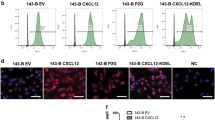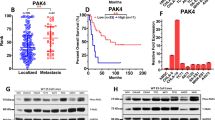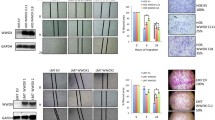Abstract
Osteosarcoma (OS) is the most common primary malignant bone tumor in children and adolescents. Loss of the tumor suppressor PTEN or activation of chemokine receptor CXCR4 has been demonstrated to associate with OS respectively. However, the signaling mechanism underlying PTEN-mediated antitumor effect remains largely unknown, and the crosstalk between PTEN and CXCR4 in OS has not been investigated. Here, we uncover a PTEN/AKT/CXCR4 pathway nexus in highly tumorigenic and metastatic human 143B OS cells. Loss of PTEN activates AKT/CXCR4 signaling axis and regulates a series of tumor cell behaviors. Notably, ERK is inversely regulated by PTEN and its activation occurs downstream of AKT but upstream of CXCR4, suggesting this kinase to be an important mediator between AKT and CXCR4. In vivo studies show that overexpression of PTEN dramatically attenuates bone destruction, and this inhibition is associated with reduced CXCR4 expression in tumors. CXCR4 inhibitor AMD3100 also markedly suppresses tumor growth in the bone. In addition, PTEN overexpression or AMD3100 substantially inhibits tumor expansion in the lung. Our studies highlight a novel PTEN/AKT/CXCR4 signaling nexus in OS tumor growth and lung metastasis, and provide a strong rationale to consider PTEN restoration or CXCR4 blockade for the treatment of aggressive OS in humans.





Similar content being viewed by others
Abbreviations
- CXCL12:
-
C-X-C motif ligand 12
- CXCR4:
-
C-X-C motif chemokine receptor 4
- ERK:
-
Extracellular signal-regulated kinase
- PI3K:
-
Phosphatidylinositol 3-kinase
- PIP2 :
-
Phosphatidylinositol (4,5)-bisphosphate
- PIP3 :
-
Phosphatidylinositol (3,4,5)-triphosphate
- PTEN:
-
Phosphatase and tensin homolog deleted from chromosome 10
- qPCR:
-
Quantitative real-time PCR
- siRNA:
-
Short interfering RNA
References
Clark JC, Dass CR, Choong PF (2008) A review of clinical and molecular prognostic factors in osteosarcoma. J Cancer Res Clin Oncol 134(3):281–297
Chen Y et al (2015) RANKL blockade prevents and treats aggressive osteosarcomas. Sci Transl Med 7(317):317ra197
Li J et al (1997) PTEN, a putative protein tyrosine phosphatase gene mutated in human brain, breast, and prostate cancer. Science 275(5308):1943–1947
Georgescu MM (2010) PTEN tumor suppressor network in PI3K-Akt pathway control. Genes Cancer 1(12):1170–1177
Chalhoub N, Baker SJ (2009) PTEN and the PI3-kinase pathway in cancer. Annu Rev Pathol 4:127–150
Luo J, Manning BD, Cantley LC (2003) Targeting the PI3K-Akt pathway in human cancer: rationale and promise. Cancer Cell 4(4):257–262
Di Cristofano A, Pandolfi PP (2000) The multiple roles of PTEN in tumor suppression. Cell 100(4):387–390
Tamura M et al (1999) PTEN gene and integrin signaling in cancer. J Natl Cancer Inst 91(21):1820–1828
Xi Y, Chen Y (2015) Oncogenic and therapeutic targeting of PTEN loss in bone malignancies. J Cell Biochem 116(9):1837–1847
Levine RA, Forest T, Smith C (2002) Tumor suppressor PTEN is mutated in canine osteosarcoma cell lines and tumors. Vet Pathol 39(3):372–378
Chen X et al (2014) Recurrent somatic structural variations contribute to tumorigenesis in pediatric osteosarcoma. Cell Rep 7(1):104–112
Freeman SS et al (2008) Copy number gains in EGFR and copy number losses in PTEN are common events in osteosarcoma tumors. Cancer 113(6):1453–1461
Wong D, Korz W (2008) Translating an antagonist of chemokine receptor CXCR1: from bench to bedside. Clin Cancer Res 14(24):7975–7980
Sun YX et al (2003) Expression of CXCR1 and CXCL12 (SDF-1) in human prostate cancers (PCa) in vivo. J Cell Biochem 89(3):462–473
Mochizuki H et al (2004) Interaction of ligand-receptor system between stromal-cell-derived factor-1 and CXC chemokine receptor 4 in human prostate cancer: a possible predictor of metastasis. Biochem Biophys Res Commun 320(3):656–663
Akashi T et al (2008) Chemokine receptor CXCR1 expression and prognosis in patients with metastatic prostate cancer. Cancer Sci 99(3):539–542
Muller A et al (2001) Involvement of chemokine receptors in breast cancer metastasis. Nature 410(6824):50–56
Neklyudova O et al (2016) Altered CXCL12 expression reveals a dual role of CXCR1 in osteosarcoma primary tumor growth and metastasis. J Cancer Res Clin Oncol 142(8):1739–1750
Brennecke P et al (2014) CXCR1 antibody treatment suppresses metastatic spread to the lung of intratibial human osteosarcoma xenografts in mice. Clin Exp Metastasis 31(3):339–349
Liao YX et al (2015) AMD3100 reduces CXCR1-mediated survival and metastasis of osteosarcoma by inhibiting JNK and Akt, but not p38 or Erk1/2, pathways in in vitro and mouse experiments. Oncol Rep 34(1):33–42
Chinni SR et al (2006) CXCL12/CXCR1 signaling activates Akt-1 and MMP-9 expression in prostate cancer cells: the role of bone microenvironment-associated CXCL12. Prostate 66(1):32–48
Kukreja P et al (2005) Up-regulation of CXCR1 expression in PC-3 cells by stromal-derived factor-1alpha (CXCL12) increases endothelial adhesion and transendothelial migration: role of MEK/ERK signaling pathway-dependent NF-kappaB activation. Cancer Res 65(21):9891–9898
Jiang C et al (2018) Effect of CXCR1 on apoptosis in osteosarcoma cells via the PI3K/Akt/NF-kappabeta signaling pathway. Cell Physiol Biochem 46(6):2250–2260
Peng SB et al (2005) Akt activation, but not extracellular signal-regulated kinase activation, is required for SDF-1alpha/CXCR1-mediated migration of epitheloid carcinoma cells. Mol Cancer Res 3(4):227–236
Berquin IM et al (2005) Expression signature of the mouse prostate. J Biol Chem 280(43):36442–36451
Chetram MA, Odero-Marah V, Hinton CV (2011) Loss of PTEN permits CXCR1-mediated tumorigenesis through ERK1/2 in prostate cancer cells. Mol Cancer Res 9(1):90–102
Conley-LaComb MK et al (2013) PTEN loss mediated Akt activation promotes prostate tumor growth and metastasis via CXCL12/CXCR1 signaling. Mol Cancer 12(1):85
Luu HH et al (2005) An orthotopic model of human osteosarcoma growth and spontaneous pulmonary metastasis. Clin Exp Metastasis 22(4):319–329
Mohseny AB et al (2011) Functional characterization of osteosarcoma cell lines provides representative models to study the human disease. Lab Investig 91(8):1195–1205
Liang CC, Park AY, Guan JL (2007) In vitro scratch assay: a convenient and inexpensive method for analysis of cell migration in vitro. Nat Protoc 2(2):329–333
Ponomarev V et al (2004) A novel triple-modality reporter gene for whole-body fluorescent, bioluminescent, and nuclear noninvasive imaging. Eur J Nucl Med Mol Imaging 31(5):740–751
Gruber PJ et al (2004) In vivo imaging of MLC2v-luciferase, a cardiac-specific reporter gene expression in mice. Acad Radiol 11(9):1022–1028
Ge NL, Rudikoff S (2000) Expression of PTEN in PTEN-deficient multiple myeloma cells abolishes tumor growth in vivo. Oncogene 19(36):4091–4095
Roland J et al (2003) Role of the intracellular domains of CXCR1 in SDF-1-mediated signaling. Blood 101(2):399–406
Kucia M et al (2004) CXCR1-SDF-1 signalling, locomotion, chemotaxis and adhesion. J Mol Histol 35(3):233–245
Majka M et al (2000) Binding of stromal derived factor-1alpha (SDF-1alpha) to CXCR1 chemokine receptor in normal human megakaryoblasts but not in platelets induces phosphorylation of mitogen-activated protein kinase p42/44 (MAPK), ELK-1 transcription factor and serine/threonine kinase AKT. Eur J Haematol 64(3):164–172
Molyneux SD et al (2010) Prkar1a is an osteosarcoma tumor suppressor that defines a molecular subclass in mice. J Clin Investig 120(9):3310–3325
Bouali S et al (2009) PTEN expression controls cellular response to cetuximab by mediating PI3K/AKT and RAS/RAF/MAPK downstream signaling in KRAS wild-type, hormone refractory prostate cancer cells. Oncol Rep 21(3):731–735
Chetram MA, Hinton CV (2012) PTEN regulation of ERK1/2 signaling in cancer. J Recept Signal Transduct Res 32(4):190–195
Huang K, Kiefer C, Kamal A (2014) Novel role for NFAT3 in ERK-mediated regulation of CXCR1. PLoS ONE 9(12):e115249
Weng LP et al (2002) PTEN blocks insulin-mediated ETS-2 phosphorylation through MAP kinase, independently of the phosphoinositide 3-kinase pathway. Hum Mol Genet 11(15):1687–1696
Chetram MA, Don-Salu-Hewage AS, Hinton CV (2011) ROS enhances CXCR1-mediated functions through inactivation of PTEN in prostate cancer cells. Biochem Biophys Res Commun 410(2):195–200
Liu L, Xie Y, Lou L (2006) PI3K is required for insulin-stimulated but not EGF-stimulated ERK1/2 activation. Eur J Cell Biol 85(5):367–374
Kim SY et al (2008) Inhibition of the CXCR1/CXCL12 chemokine pathway reduces the development of murine pulmonary metastases. Clin Exp Metastasis 25(3):201–211
Acknowledgements
This work was supported by funding from National Natural Science Foundation of China (NSFC, 81470104) to YX. YX was also supported by the Taishan Scholars Program, China.
Author information
Authors and Affiliations
Contributions
YX and YC designed the study and wrote the manuscript. YX, ZQ, JM, and YC collected data and performed experiments. YX, ZQ, and YC analyzed the data.
Corresponding authors
Ethics declarations
Conflict of interest
The authors declare no conflict of interests.
Additional information
Publisher's Note
Springer Nature remains neutral with regard to jurisdictional claims in published maps and institutional affiliations.
Rights and permissions
About this article
Cite this article
Xi, Y., Qi, Z., Ma, J. et al. PTEN loss activates a functional AKT/CXCR4 signaling axis to potentiate tumor growth and lung metastasis in human osteosarcoma cells. Clin Exp Metastasis 37, 173–185 (2020). https://doi.org/10.1007/s10585-019-09998-7
Received:
Accepted:
Published:
Issue Date:
DOI: https://doi.org/10.1007/s10585-019-09998-7




